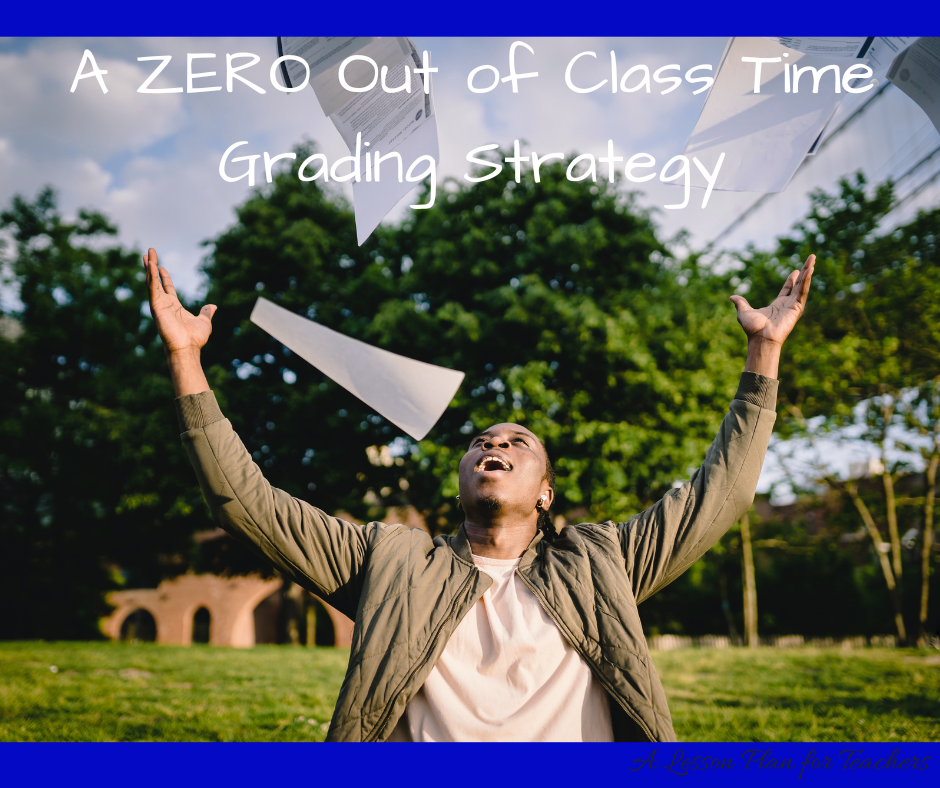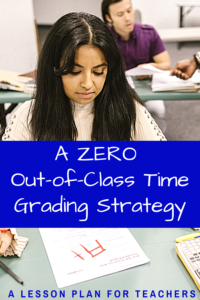Grading can be one of the most time consuming, and stressful parts of teaching. It shouldn’t be that way. And it doesn’t have to be that way, either! Learn this easy to implement zero out-of-class time grading strategy to save yourself time and energy, while also providing your students the engagement and feedback they need for success.

An Effective Grading Strategy
Effectiveness in your grading strategy is key in helping your classroom be successful. “Grades” is truly just a shorthand expression for assessment. And assessment is vital for students to attain growth.
It’s also important to note that not all assessments are the same. Summative assessments are those we typically hear about, and often the ones students (and teachers) fear. That should not be the case! In reality, students should be formatively assessed on a daily basis, so that by the time the summative assessment comes around, they are fully prepared.
The formative assessment is your day to day evaluation of your students’ progress. This is what we want to focus on to reduce your time obligation, and also to improve the feedback you give your students.
Formative Grading Strategy 101
First of all, remember the purpose for formative assessments: to help make immediate corrections and guide the students toward greater understanding and academic improvement. And based on that definition, formative assessments should not be time consuming or anxiety-riddled! Consider these assessments for your zero out-of-class time grading strategy classroom:
- Walk-by Assessments – you do this every day and yet, you probably do not give yourself credit for doing so! This assessment is also the easiest. But guess what? It’s also the most effective for your students. As students are completing tasks or practicing skills, your one-to-one redirections and guidance can help them do better, while also helping to build an academic relationship based on trust and kindness that will help them engage further in the future.
- Collaborative Assessments – these are very important for a number of reasons, most importantly because they build student rapport and help students practice actually processing information. We too often stress gathering knowledge, yet we seldom encourage students to take the time to process it. Small group collaboration is extremely valuable in helping students achieve this. And it’s a perfect time for you to practice collaborative assessments. Visit each group. Ask simple, but developing questions to assess their knowledge and push them further in their discovery.
- Whole Class Assessments – these should be done DAILY! Let me say that again – DO THESE EVERY SINGLE DAY! This is the wrap-up of your daily lesson. And they are so important. They let you know who is not he boat and who is over the side sinking in the deep ocean waters. Ask individuals to share what they learned. Use spiral questing and involve all students in the review of the lesson. Encourage creative expression and let the wrap-up be intrinsic and interactive. Play games!
- Exit Assessments – these are one of the easiest ways to check on your students and yet one of the least done! My students all keep an interactive notebook. Link here to learn more about that format – it’s not what you’d expect. At the end of class (last 3 minutes), my students had to complete their exit prompt. As students wrote, drew, charted, mapped… their responses, I went around and read them over their shoulders. Or some days I stood at the door where they had to show me their response to exit. And if the response is not up to par, have them sit back down and work on it more. Expect what you want to see and hold them accountable to get there.
A Few Standout Questions
What about grading the things your students DO? How do you grade worksheets, tasks, reading assessments…?
- See the above section titled Formative Grading Strategy 101. Go over these assignments in small groups and then as a whole class to check that everyone is on the same page. Expect them to make corrections to their work. Walk around as you are going over the correct information to make sure they are doing the corrections.
- Require students to keep an interactive notebook. Grade it as suggested in this post. This is important for so many reasons, but it is also a great way for you to check off their work AND their understanding on a daily basis.
What about skills practice? How can you assess individual students in regard to completion of skills versus tasks?
- Practice! Have students practice skills on the board. Do activities as a whole class. Use Think-Pair-Share activities so students are demonstrating they can complete the skill to move to the next stage.
- Utilize interactive learning strategies where students must complete skill 1 to move on to skill 2. This is the entire premise of Inquiry-Based Learning, Project-Based Learning, Escape Rooms… And they all work!
What do I put in the Gradebook?
- Oh, yes! That! This could lead to a whole other discussion, but I will keep the response here simple – assess! Use the tips in the linked post above on grading. Use a checklist (I preferred the paper version over the online due to ease and my ability to have an extended view). A check could equal 10 points. Add them up on Fridays to enter 50/50 in the gradebook. If they give less effort or need to revise, reduce the point value. If they did not complete the assignment, give a zero. Grades are NOT the end result – Learning is!
- Your summative assessments will be the stronghold for actual data-driven grades. These are the ones that only the College Board care about. Let them serve that purpose. On the flip side of that, I also encourage more creative options for even summative assessments. They work!
Wrap It Up!

In the end, it’s a fact that education should not be about the grade we put in the computer. It should be about the learning that takes place in our classrooms. And not every strategy will work for every teacher. But you can still find a zero out-of class time grading strategy that will work for you. Focus on that!
Need some help finding that focus? Start with a Growth Mindset Guide and Map. They aren’t only great to help students find focus, they are good for teachers to do, too!
Happy Teaching!
